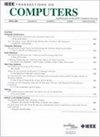A Dynamic Adaptive Framework for Practical Byzantine Fault Tolerance Consensus Protocol in the Internet of Things
IF 3.6
2区 计算机科学
Q2 COMPUTER SCIENCE, HARDWARE & ARCHITECTURE
引用次数: 0
Abstract
The Practical Byzantine Fault Tolerance (PBFT) protocol-supported blockchain can provide decentralized security and trust mechanisms for the Internet of Things (IoT). However, the PBFT protocol is not specifically designed for IoT applications. Consequently, adapting PBFT to the dynamic changes of an IoT environment with incomplete information represents a challenge that urgently needs to be addressed. To this end, we introduce DA-PBFT, a PBFT dynamic adaptive framework based on a multi-agent architecture. DA-PBFT divides the dynamic adaptive process into two sub-processes: optimality-seeking and optimization decision-making. During the optimality-seeking process, a PBFT optimization model is constructed based on deep reinforcement learning. This model is designed to generate PBFT optimization strategies for consensus nodes. In the optimization decision-making process, a PBFT optimization decision consensus mechanism is constructed based on the Borda count method. This mechanism ensures consistency in PBFT optimization decisions within an environment characterized by incomplete information. Furthermore, we designed a dynamic adaptive incentive mechanism to explore the Nash equilibrium conditions and security aspects of DA-PBFT. The experimental results demonstrate that DA-PBFT is capable of achieving consistency in PBFT optimization decisions within an environment of incomplete information, thereby offering robust and efficient transaction throughput for IoT applications.物联网中实用拜占庭容错共识协议的动态自适应框架
由实用拜占庭容错(PBFT)协议支持的区块链可以为物联网(IoT)提供去中心化的安全和信任机制。然而,PBFT 协议并非专为物联网应用而设计。因此,如何使 PBFT 适应信息不完整的物联网环境的动态变化是一个亟待解决的挑战。为此,我们引入了基于多代理架构的 PBFT 动态自适应框架 DA-PBFT。DA-PBFT 将动态自适应过程分为两个子过程:优化搜索和优化决策。在寻求优化过程中,基于深度强化学习构建了一个 PBFT 优化模型。该模型旨在为共识节点生成 PBFT 优化策略。在优化决策过程中,基于博尔达计数法构建了 PBFT 优化决策共识机制。该机制确保了 PBFT 优化决策在不完全信息环境中的一致性。此外,我们还设计了一种动态自适应激励机制,以探索 DA-PBFT 的纳什均衡条件和安全性。实验结果表明,DA-PBFT 能够在不完全信息环境中实现 PBFT 优化决策的一致性,从而为物联网应用提供稳健高效的交易吞吐量。
本文章由计算机程序翻译,如有差异,请以英文原文为准。
求助全文
约1分钟内获得全文
求助全文
来源期刊

IEEE Transactions on Computers
工程技术-工程:电子与电气
CiteScore
6.60
自引率
5.40%
发文量
199
审稿时长
6.0 months
期刊介绍:
The IEEE Transactions on Computers is a monthly publication with a wide distribution to researchers, developers, technical managers, and educators in the computer field. It publishes papers on research in areas of current interest to the readers. These areas include, but are not limited to, the following: a) computer organizations and architectures; b) operating systems, software systems, and communication protocols; c) real-time systems and embedded systems; d) digital devices, computer components, and interconnection networks; e) specification, design, prototyping, and testing methods and tools; f) performance, fault tolerance, reliability, security, and testability; g) case studies and experimental and theoretical evaluations; and h) new and important applications and trends.
 求助内容:
求助内容: 应助结果提醒方式:
应助结果提醒方式:


